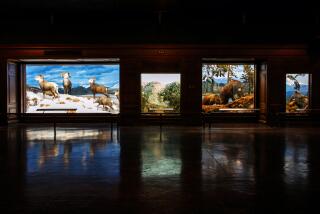Touched by Animals
- Share via
Artist Gregory Colbert made a friend in Borneo. They saw each other from a distance. The young mother was wary and held her baby tightly to her as she approached Colbert’s expedition. Though she and Colbert shared no common language, they sat quietly together and communicated through touch and gesture.
“I think one of the best moments,” Colbert recounted recently, “was when she took a piece of fruit out of her mouth and put it in my mouth. So I put a piece of fruit in my mouth, and then took it out and put it in hers. She certainly had no problem crossing species lines.”
Colbert’s new friend, an orangutan, is one of the animals whose interactions with humans are the subject of the 45-year-old Canadian’s traveling exhibit, “Ashes and Snow,” opening Jan. 14 at the Nomadic Museum--a massive, albeit temporary, collection of 152 shipping containers adjacent to the Santa Monica Pier.
The exhibit, which first opened in 2002 at the Arsenale, a 125,000-square-foot shipyard in Italy, drew more than 100,000 visitors. “Ashes and Snow” became mobile in 2005 with the creation of the Nomadic Museum, designed by avant-garde Japanese architect Shigeru Ban; its first port of call was New York City’s Pier 54 in March 2005. After the show closes May 14 in Santa Monica, it will go to Beijing and then to other cities around the U.S. and abroad.
Colbert describes the show as a bestiary, featuring film as well as photos. Visitors will see more than 100 large-scale “totemic” images of animals with which Colbert and his crew interacted in such places as India, Egypt, Myanmar, Tonga, Sri Lanka, Antarctica, Namibia and Borneo. Colbert mounted 34 expeditions over 14 years collecting material. He is supported by patrons, with his work fetching up to $200,000 per image.
The exchanges documented by Colbert--a boy reading to an elephant; a woman dancing as an eagle flies past and grazes her; Colbert diving with sperm whales--exist outside the sphere in which man and animal usually collide. There is no clash of species in “Ashes and Snow”; it is a world in which man and animals peacefully co-exist, living in each other’s dreams.
One might be tempted to dismiss it as fantasy and environmental idealism were it not for the fact that Colbert hasn’t manipulated a single image. Every interaction--whether with elephants, whales, baboons, crocodiles or eagles--took place through a willingness to let the interactions unfold at the animals’ pleasure.
“If elephants had an ‘I Have a Dream’ speech, this would be it,” says the intense but soft-spoken Colbert. “Species-ism is really a close relation to racism. Children don’t see differences in race, just as up to the age of 10 they tend to see animals as equals. This is one of the things people experience in this exhibition, that sense of connection between ourselves and nature.”
More to Read
Sign up for The Wild
We’ll help you find the best places to hike, bike and run, as well as the perfect silent spots for meditation and yoga.
You may occasionally receive promotional content from the Los Angeles Times.






